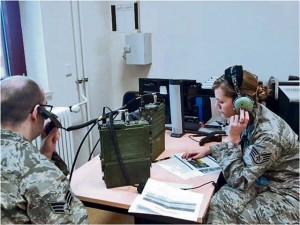Air Force and Army combat specialists from the 2nd Air Support Operations Squadron, 2nd Stryker Cavalry Regiment and 2nd Battalion, 159th Aviation Regiment had a chance to demonstrate their ability to exercise effective command and control during a recent exercise designed to test their ability to assault a simulated enemy compound.
The exercise, which took place at the Grafenwöhr Training Area, consisted of approximately 50 members training with and against several ground and aerial platforms, including Army Strykers, UH-60 Blackhawks and AH-64 Apaches.

Senior Airman Charles Blumel, 2nd Air Support Operations Squadron RF transmission journeyman, and Staff Sgt. Hailey Sundberg, 2nd Weapons director craftsman, provide close air support and command and control during a recent air assault exercise at the Grafenwöhr Training Area.
“The training provided us a chance to work with our Army counterparts, which is not something we get to do every day,” said Senior Airman Bobby McDonald, 2nd ASOS joint terminal attack controller. “This is important for us, especially our younger JTACs, because our job supports Army combat units. We provide close air support, resupply drops, air assaults and several other tactical functions in order to protect friendly forces and prevent unnecessary danger to their lives.”
McDonald added that JTACs go through rigorous training prior to arriving at their first duty station. Technical training takes more than two years to complete and requires them to attend several schools around the U.S.
“What we do is necessary, because we bring a critical capability to the fight,” McDonald said. “The skills we bring to the fight are very complex and sophisticated, and there is no room for error. Training like this is vital to maintaining our ability to do our job.”
The young Airmen weren’t the only ones to benefit from the combined training. Tech. Sgt. Jason Basaldua, 2nd ASOS A flight NCOIC, said this was one of the first times JTACs operated in the air as well as the ground.
“We had a chance to get our JTACs in a Blackhawk for this exercise, which is not something we normally do,” he said. “It offered our members a unique perspective, because we are usually on the ground. Being able to see the action from the pilot’s perspective was amazing and gave me a clearer picture of what happens from all angles.”
Lt. Col. David Ferguson, 2nd ASOS commander, said future training like this will possibly include other elements, enhancing the mission capability and understanding of the participants.
“These types of exercises are a major win for joint combined arms training, and we are exploring the feasibility of including partner nation participation in future efforts,” he said.
Basaldua added that this is the first of many training sessions planned for the 2nd ASOS, and they intend to continue incorporating different challenges to increase the difficulty in order to improve the experience of the JTACs.
“This training was only the first step in a bigger plan,” Basaldua said. “If we are not out there doing the job, we are back here training so we are ready. With the training we are doing now, the members of the 2nd ASOS should be ready to handle anything.”







